THE INSIDE TRACK • August 2023
Eight things you didn’t know about our Global Learning Academy
Simulated emergencies, life-saving skills, talented colleagues: our state-of-the-art training facility is where composure and precision play out side by side – and all just a hop, skip and a jump away from the heart of Heathrow T5. Rest assured, if our Global Learning Academy is a mystery to you now, it won’t be by the time you read this…
“Evacuate! Evacuate!” our trainee calls out with a calm urgency. Her hair is slicked back into a neat bun as she opens the replica plane door with ease, as if popping the lid from a jar of jam. “Open seat belts, leave bags,” she continues. There’s a pause as she monitors the situation around her, and then: “Wait. Wait. Slide inflating.” And, finally, “Jump. Jump. Keep moving. Jump.”
This is a typical scene inside our Global Learning Academy (GLA) five miles from London Heathrow – a prestigious training facility serving as the foundation for thousands of talented colleagues across British Airways. Here, delivering superb service while ensuring the utmost safety for passengers is our top priority. Curious about what goes on within? Here are eight things to know…
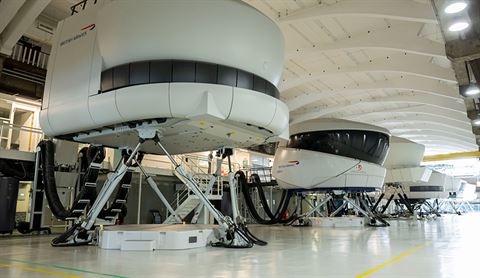
Inside our Flight Simulators Hall, where pilots train and are examined every six months
It’s a mighty operation
The GLA is located within our Heathrow engineering base, which, as well as colleague training, carries out aircraft maintenance services and ground handling. This involves any handling of aircraft on the ground, such as providing access via steps or pushing the aircraft back on to the taxi way. Inside the GLA itself, you’ll find a vast array of resources: a 16-bay simulator hall, our Safety Equipment & Procedures hall (SEP), engineering hangars and facilities, classrooms, and multiple cabin mock-ups. There’s also an on-site restaurant and café to ensure trainees remain fuelled up throughout their rigorous training.
Training for cabin crew lasts six weeks
The journey for our cabin crew – who, alongside all colleagues, earn their stripes right here at the GLA – starts with six weeks of intense initial training. These aspiring professionals undergo a blend of practical and theoretical examinations, classroom-based learning, online modules, and dedicated revision at home. They cover a diverse range of essential skills, encompassing safety procedures, medical training, customer service, survival training, dangerous goods handling, conflict management, medical training, delivery standards and much more. They’re trained to qualify on core aircraft types (the A320 family, B777 and B787), with additional A350 or A380 qualifications.
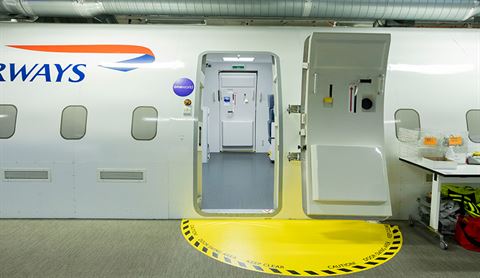
Mock cabins combine theoretical teachings with practical applications
Safety is the #1 priority
Whether you work on the ground or at 35,000 feet, it’s safety first at British Airways – always. While cabin crew excel at providing exceptional cabin service, their primary responsibility is to ensure the safety and security of passengers. From handling fire and smoke situations to operating doors and slide descents, the academy imparts the necessary skills for any and every emergency scenario, while water survival training is carried out at a nearby swimming pool.
But that’s not all – cabin crew are trained to be conscious of their own safety, too. Before passengers board, they are taught how to check their own protective and emergency equipment – including fire extinguishers, portable oxygen, life jackets, torches, smoke hoods and gloves – mostly located next to their assigned door and seat.
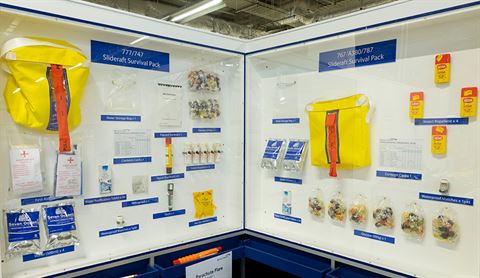
A slideraft survival pack for Boeings 777 and 747, B767 and B787, and A380
These are no ordinary classrooms
Our range of immersive cabin mock-ups – some complete with working galleys, crockery and smoke generators – allow theory to be put into practice: “The whole concept of the Customer Service Training mock-ups is that you’re moving through the aircraft in its natural state, so you have First up front, then Club World, World Traveller Plus and World Traveller,” Louise Oleszczuk, GLA Commercial Delivery Manager, explains. These environments replicate real-life situations, enabling trainees to learn life-saving defibrillator techniques, efficient fire-fighting procedures and seamless multi-course meal service to passengers. “This is where we teach our unique way of service, which is so essential to the British Airways brand,” she adds.
Safety is an ever-evolving responsibility, and British Airways ensures its colleagues are always at the top of their game
Training is ongoing
Safety is an ever-evolving responsibility, and British Airways ensures its colleagues are always at the top of their game – the academy is very rarely closed. Cabin crew members undergo reassessment every year, in what’s known as ‘recurrent training’. This two-day process involves practical and theoretical assessments, testing everything from gut instinct to hazards and an individual’s response to challenging situations – and any crew member not meeting the required standard is given further training before retaking the assessment.
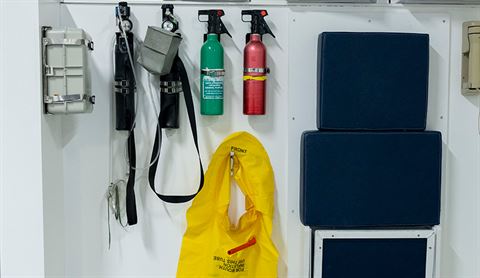
From left to right: smoke hood, oxygen, BCF fire extinguisher, life jacket and torch
Our academy includes a 16-bay flight simulator hall
Pilots’ licences undergo thorough scrutiny every six months in our CAA-approved flight simulator hall. During a four-hour examination, accompanied by an hour-long pre-examination briefing, pilots are challenged with various scenarios, testing their critical decision-making and adherence to standard operating procedures. The tests encompass take-off and landing, engine failure simulations and crosswind handling.
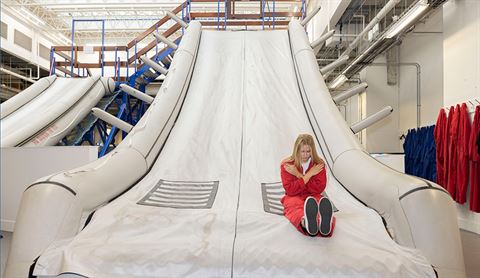
Black deacceleration strips at the bottom of the slide are designed to slow your descent
There’s a slide show (sort of)
In emergencies, every second counts – and just six seconds are needed to inflate the evacuation slide. All cabin crew are taught how to correctly descend the slides and are trained to use them as emergency life rafts, complete with a canopy setup to protect passengers in a water landing scenario. The SEP hall itself houses two types of slides: a short-haul A320 slide and a higher, 60ft-long B747 long-haul slide, ensuring crew members are proficient in operating slides on all aircraft types.
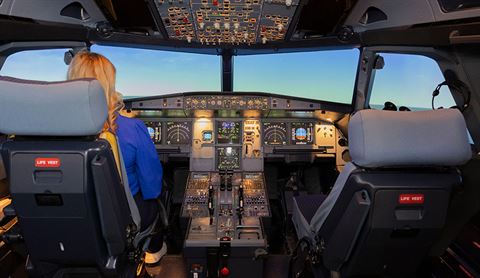
Pilots are tested in a variety of scenarios within their four-hour examination
There are multiple doors to master
The air echoes with door drill procedures within our SEP hall, as cabin crew are examined in multiple versions, from short-haul A320 to B777, B787, A380 and A350 doors. These simulations encompass various hazards, such as fire, water landings (known as ‘ditching’), and embarkation and disembarkation through jet bridges. Trainers, who include AJ Jardine, emphasise the importance of following correct standard operating procedures while challenging trainees with surprise scenarios to simulate real-life situations. “In real life situations, you must be able to deal with what’s presented to you,” AJ explains. “Learning how to do this in training prepares crew for the real world.”
The Global Learning Academy stands as a testament to British Airways’ unwavering commitment to excellence in service and safety. Through meticulous training and unwavering dedication, the esteemed institution shapes individuals who can confidently handle any situation that may arise in the skies.
This article has been tagged BA
More from previous issues

Can you guess the runway?
Check out some of the world’s most stunning take-off and landing strips in this issue’s aerial quiz. Good luck!

The flight diaries: Cincinnati, USA
We’re flying somewhere new this month, so we made sure an eagle-eyed Club correspondent was on board the first flight to report back
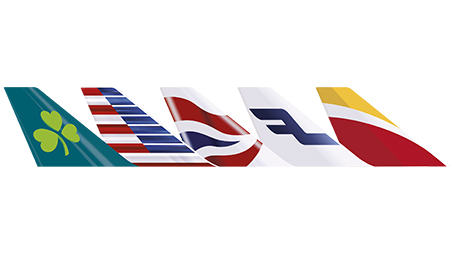
An easier way to explore America
Our partnership with other airlines means more routes and more flexibility: here’s how to crack the system ready for your next trip
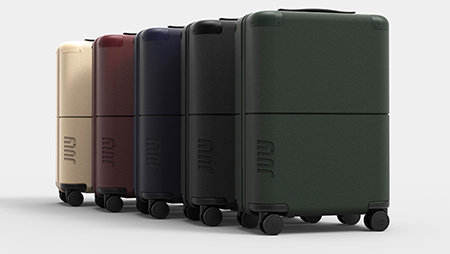
Match maker: baggage combos for every kind of traveller
Pack like a pro and bag yourself a new set this summer, with this guide to the most dazzling duos on the market right now
